A quantification of damage and assessment of economic loss due to crop raiding by Asian Elephant Elephas maximus (Mammalia: Proboscidea: Elephantidae): a case study of Manas National Park, Assam, India
Naba K. Nath 1, Sushil K. Dutta 2, Jyoti P. Das 3 & Bibhuti P. Lahkar 4
1 State Resource Centre Dispur, 31, Jatia, Kahilipara Road, Dispur, Guwahati, Assam 781006, India
2 Centre for Ecological Sciences, Indian Institute of Science, Bengaluru, Karnataka 560012, India
3,4 Aaranyak, 50, Samanwoy Path, Survey, Beltola, Guwahati, Assam 781028, India
1 nabanath@gmail.com (corresponding author), 2 dutta@ces.iisc.ernet.in, 3 jyoti@aaranyak.org, 4 bibhuti@aaranyak.org
doi: http://dx.doi.org/10.11609/JoTT.o4037.6853-63
Editor: Mewa Singh, University of Mysore, Mysuru, India. Date of publication: 26 February 2015 (online & print)
Manuscript details: Ms # o4037 | Received 23 May 2014 | Final received 03 January 2015 | Finally accepted 30 January 2015
Citation: Nath, N.K., S.K. Dutta, J.P. Das & B.P. Lahkar (2015). A quantification of damage and assessment of economic loss due to crop raiding by Asian Elephant Elephas maximus (Mammalia: Proboscidea: Elephantidae): a case study of Manas National Park, Assam, India. Journal of Threatened Taxa 7(2): 6853–6863; http://dx.doi.org/10.11609/JoTT.o4037.6853-63
Copyright: © Nath et al. 2015. Creative Commons Attribution 4.0 International License. JoTT allows unrestricted use of this article in any medium, reproduction and distribution by providing adequate credit to the authors and the source of publication.
Funding: US Fish & Wildlife Service. Award Numbers: 98210-5-G259 (Financial Year: 2005) and 98210-7-G211 (Financial Year: 2007).
Competing Interest: The authors declare no competing interests.
Author Contribution: NKN was involved in field data collection, data processing, data analysis and writing the paper. SKD supervised the study, helped during data analysis and reviewed the paper. JPD helped in data analysis. BPL coordinated the entire project under which this study was carried out and also reviewed the paper.
Author Details: Naba Krishna Nath is a Programme Coordinator of State Resource Centre Dispur. He completed PhD on HEC in Manas National Park. He completed several research projects on Asian Elephant, Hispid Hare, bird community structure, camera trapping of tigers, etc. He is now working on the social aspects of HEC. Sushil Kumar Dutta, one of the renowned herpetologists of the world and prominent developmental biologist of India, has authored several books and more than 100 research articles. He is a member of different scientific and technical committees of Government of India and involved in conservation policy making. Jyoti P. Das is a field biologist associated with Aaranyak since 2005. He has been conducting research on large mammal ecology in Assam and is presently involved in identifying spatial patterns of HEC and present status of corridors in Golaghat District, Assam. Bibhuti P. Lahkar is the Programme Secretary of Aaranyak. He has been conducting research and monitoring of the grassland ecosystem dynamics in Manas National Park since 2001. He coordinates the Asian Elephant Research & Conservation Programme of Aaranyak.
Acknowledgement: The study was funded by the Asian Elephant Conservation Fund of US Fish and Wildlife Service. We gratefully acknowledge Mr. M.C. Malakar, the Chief Wildlife Warden of Assam State Forest Department for granting us permission to work in MNP and for providing logistic facilities. We are equally grateful to Dr. Abhijit Rabha, Mr. Ritesh Bhattacharjee, Mr. Anindya Swargowary, Mr. C.R. Bhobora and the entire forest staff of MNP for their help and assistance during the study. We are extremely thankful to Mr. Surendra Varma for his invaluable suggestions and technical support. Our thanks to all the villagers for their cooperation without which this study would not have been possible.
Abstract: A study was carried out in Manas National Park, Assam in northeastern India between 2007 and 2009 to understand the magnitude of human-elephant conflict through a quantification of damage and assessment of economic loss. A cluster of six villages adjacent to the Park was selected for this study. Five major agricultural crops were grown during the study period of which three were raided by elephants: winter paddy, autumn paddy and pulses. Paddy was the principle crop central to the farmers’ subsistence. Winter paddy was the most cultivated crop and autumn paddy was the least cultivated. The incidence rate of crop raiding was highest for autumn paddy and lowest for pulses. Overall economic loss due to crop raiding was negligible, however at the individual farmer level, it was quite high. The study revealed that human-elephant conflict is not so severe, indicating ample opportunity for human-elephant coexistence in the region. Crop fields adjacent to the Park were particularly vulnerable to crop raiding which necessitates creation of a buffer zone. The frequency of raiding and the extent of damage was found to be significantly less in crop fields which were guarded by farmers. This was due to traditional crop guarding practices being followed in the region, the strengthening of which could effectively reduce annual crop loss and thus human-elephant conflict could be minimized to a large extent.
Keywords: Assam, crop raiding, economic loss, Elephant, India, Manas National Park.
Abbreviations: HEC - Human-elephant conflict; INR - Indian Rupees; US$ - United States Dollar; IR - Incidence Rate; MNP - Manas National Park.

INTRODUCTION
As human population encroaches upon natural habitat, animals find themselves increasingly in competition with people for resources (Pimm et al. 1995; Balmford et al. 2001). The conflict emerges when wildlife and human requirements overlap with consequential costs to humans and wild animals (Osei-Owusu & Bakker 2008). Large herbivores and carnivores are particularly affected by conflict and, as a result, they are either critically endangered or rapidly declining (Woodroffe & Ginsberg 1998). Human-elephant conflict (HEC) refers to a range of direct and indirect negative interactions between humans and elephants which potentially harm both the species (Ngure 1995; Lahm 1996; Ekobo 1997). HEC affects social and economic security of farmers and challenges conservation of elephants in their home-range. This conflict is a cause for concern because it threatens to erode local support for conservation in areas where human life and property are at high risk of destruction by wild elephants (Williams & Johnsingh 1997; Thouless 1994; Lahm 1996). Varma et al. (2008) emphasized that site specific study on HEC is important to understand the cause and the degree of conflict, as it would further help in mitigation of the problem. The extent of HEC is measured best in terms of economic loss since conflict results in a direct economic loss to the local communities living close to elephant habitats. In most cases in rural India, agriculture is the backbone of an individual’s economy and therefore, a loss to crop due to conflict has an adverse effect on society (Varma et al. 2008). Considering the importance of this highly sensitive issue, this present study was carried out in the fringe areas around Manas National Park (MNP) which was the first ever detailed assessment in Assam to understand the magnitude of HEC through a quantification of damage and assessment of economic loss.
MATERIALS AND METHODS
Study area
MNP is located (26035’–26050’N & 90045’–91015’E) within Chirang-Ripu Elephant Reserve at the foothills of the Bhutan Himalaya in Baksa and Chirang districts of Bodoland Territorial Areas District, in Assam, India (Fig. 1). MNP is one of the prime habitats of Asian elephants within the Bhutan Biological Conservation Complex in the Eastern Himalaya Biodiversity Hotspot (CEPF 2005) with a fluctuating population of around 500 individuals. During the mid 1980s till the late 1990s the entire Manas landscape experienced a severe socio-political crisis (Rahmani et al. 1988, 1989) which caused a large scale destruction of wildlife and its habitat. The problem of political unrest was settled in the year 2003; however, this decade-long crisis considerably changed the land use and land cover pattern of the region and caused a detrimental effect on wildlife leading to the local extinction of the Great Indian One-horned Rhinoceros Rhinoceros unicornis and Swamp Deer Cervus duvauceli ranjitsinghi, loss of habitat due to deforestation followed by encroachment, habitat degradation due to overexploitation of resources and escalation of HEC in the fringe villages (Sarma et al. 2008; Nath et al. 2009).
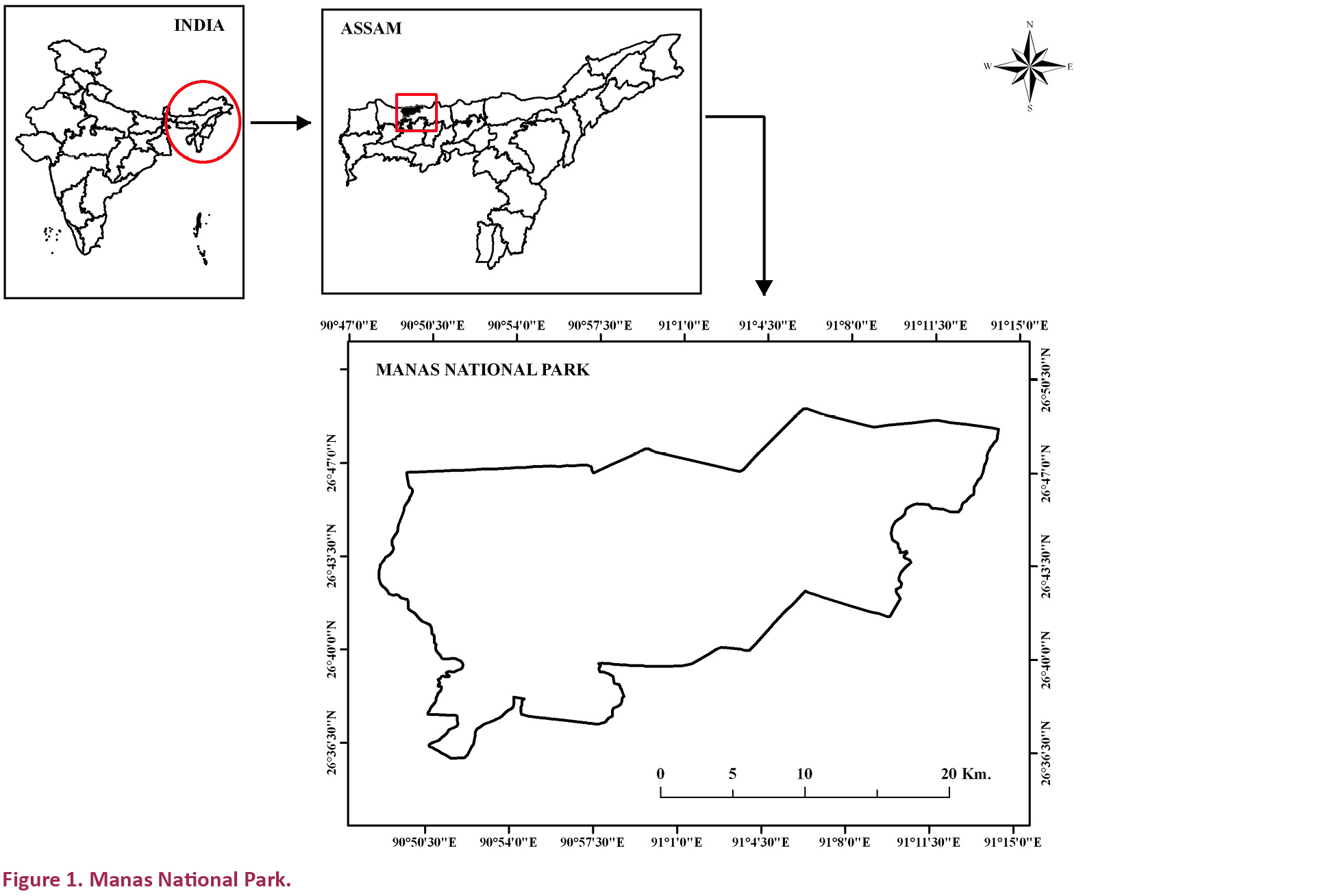
Methods
This study was carried out from the period 2007 to 2009 in Bhuyanpara Range (26041’39.9”N & 91007’29.0”E) of MNP in a cluster of six villages comprising ~900ha of extensive agricultural crop cultivation. The selected villages lie adjacent to each other, located at the border of MNP and are particularly vulnerable to crop raiding (Fig. 2). Data on crop damage was collected by visiting the villages regularly and also by talking to the village secretary, the president and the village head to collect all information on conflict incidents. To assess and quantify the damage to both standing and stored crops and man-made structural properties we followed Varma & Lahkar (2006).
The total area cultivated was measured for each crop with a measuring tape. The cumulative area was then calculated by adding the area under cultivation of each crop by each farmer during different seasons in a year.
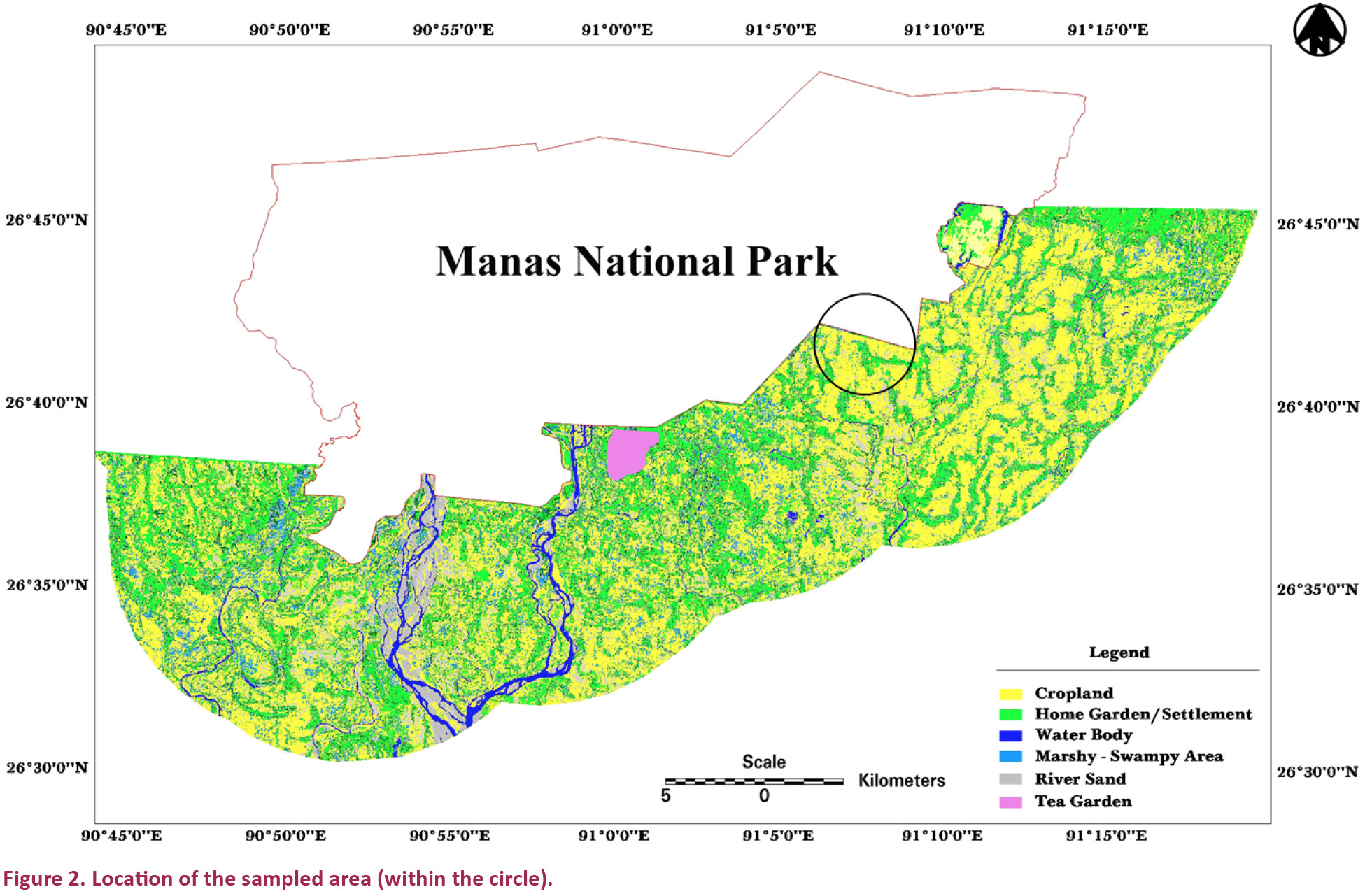
The incidence rate (IR) was calculated for the affected crops following the methodology described by Nijman & Nekaris (2010). The IR was calculated with the “total number of agricultural plots on which a crop was damaged” divided by the “total number of plots where that particular crop was present and available for raiding”. The higher-risk crops thus have an IR closer to value one (1).
Whenever damage occurred to field crops such as paddy, cereal, pulse, spice etc., the area of damage was measured using a measuring tape. Crop fields are generally uneven in shape. After carefully observing the damage, the width and length was measured estimating the equal size of a square. The area damaged was then compared to the total area cultivated to find out the percentage loss with respect to crop type and farmer.
To find out the total production, the total cultivated area with respect to each crop type was obtained. The amount of crop production was measured by laying 1x1 m2 quadrats in undamaged plots just before harvesting. Quadrats were placed randomly irrespective of the farmers’ ownership. The number of quadrats laid was in accordance with the area under cultivation for each crop type—30 for winter paddy, 20 for pulses and 10 for autumn paddy. The average dry weight of seeds (kg) obtained from each quadrat, i.e., 1m2 was multiplied by the total area of cultivation to find out the total productivity (kg) of a given crop. Although, different varieties of seeds (crops) with different productivity were used by the farmers, we categorised those varieties as a single crop type during this study.
Total productivity (kg) of a given crop was multiplied by the average market price in Indian Rupees (INR) during that period to find out the value of that particular crop. A market survey was carried out to assess the price of crops during the study period. This method was followed for all crops.
Crop loss value was calculated from the area of crop damage as had been measured. Average dry weight of seeds (kg) per m2 area was multiplied by the crop damage area, which gave the amount of crop loss. The amount of crop loss was then multiplied by the average market price of the crop to find out the value of loss of a particular crop. This method was followed for all crops.
Conflict mitigation measures being followed in MNP basically include short term (tactical) methods and the traditional crop guarding practices (platforms on trees, i.e., machaan or huts at ground-level) mostly manned by individual farmers (Nath et al. 2009). To ward off approaching raiders, the guards use noise-making activities like shouting, drum beating, bursting fire crackers, using torch/flash lights, pelting stones, throwing burning fuel-wood etc. To find out if crop guarding had any effect on the frequency of raiding and the area of crop damage, we collected information on the presence/absence of farmers guarding raided crop fields at the time of incidence.
Although it was very difficult, we tried to assess the number of elephants that came to raid the crops at night by measuring the dung and track circumference left by the animal. This information was further verified by interviewing the farmers and other villagers. The cases where authentic information could not be generated were excluded during the analysis.
During damage of structural properties, the repairing cost (for partially destroyed structures) or amount spent for reconstruction (for demolished structures) was collected by interviewing the victims. The views of victims were further verified in consultation with witnesses to avoid possible exaggeration error.
To measure and quantify the damage to stored grains was difficult since the actual amount of stored grains before the damage could not be ascertained. In this case, a qualitative information of the losses was obtained.
During field visits we also recorded the damage that occurred to vegetation other than the cultivated crops. In these cases, damage was measured based on the remains of the plant with respect to species.
Information on ex-gratia payment was obtained from the Field Director’s Office, Manas Tiger Reserve.
RESULTS
A socio-economic profile of the study area
The study area comprised a total of 563 households. The total population was recorded as 3019 and the average individual per household was 5.36 (range: 2−12 individuals). Average cultivable land holding pattern of the farmers was 0.99 ha that ranged from 0.07−10.58 ha. About 14.39% (n= 81) of the farmers were landless. The majority (56.48%, n= 318) had their land holding areas that were <1ha, while only a few had larger areas of land (Fig. 3). The main source of livelihood (69.80%, n=393) in the study area was traditional and subsistence farming. Only 8.76% of the households had an alternate source of livelihood to agricultural crop cultivation.
Five major agricultural crops were grown in the study area during the study period. These included two paddies Oryza sativa - autumn paddy (March/April−June/July) & winter paddy (June/July−November/December), pulses (Lentil, Lens culinaris and Jarosse, Lathyrus sativus) (January−March), oil seeds (Linseed, Linumusitatis simum and Indian Niger, Guizotia abyssinica) (January−March) and spice (Coriander, Coriandrum sativum) (November−February). In the study area, paddy was the principal crop which farmers considered central to their subsistence.
Total cultivable land and cumulative area under cultivation
The total cultivable land area available in the study site was 476.52ha and the cumulative area under cultivation was 1289.36ha (Table 1). Although the cumulative area under cultivation was comparatively less (1.76%) during the year 2008–09 than the previous year, there was no difference of median cumulative area under cultivation between the years (Table 1) (Wilcoxon’s test for matched pairs). During the year 2007–08, the monsoon arrived earlier with 1.36% higher annual rainfall which might have influenced farmers to cultivate slightly more land.
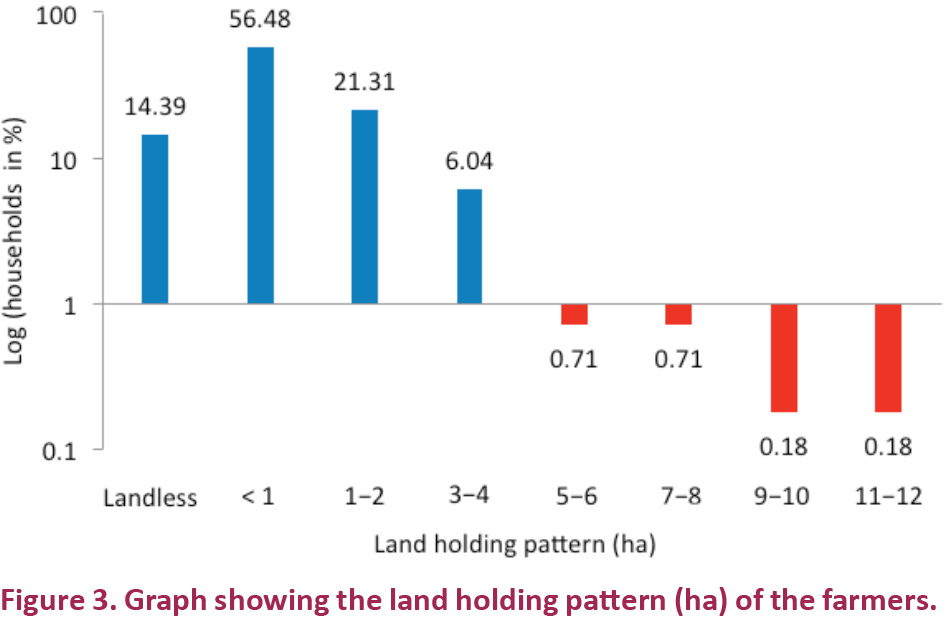

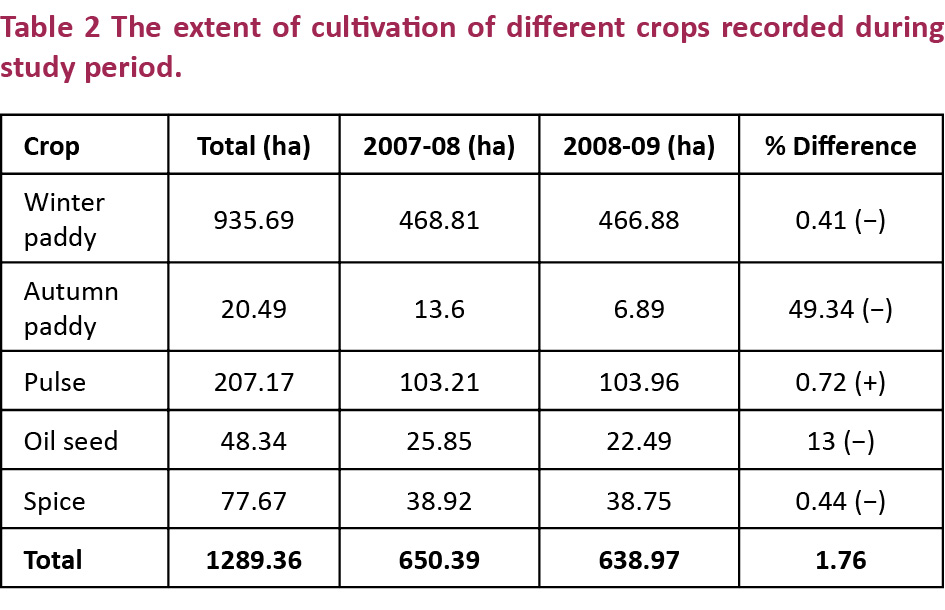
Total area under cultivation of different crops
Winter paddy was the major crop (72%) while the least cultivated crop was Autumn paddy (2%). The area under cultivation of different crops between the years was different. However, there was no difference (Wilcoxon’s test for matched pairs) and hence data of both the years were clumped before analysis (Table 2).
Occurrence of crop raiding
During the study period 38.37% (n=216) of the total households suffered elephant depredation that included crop raiding and damage to structural properties including stored grains. A total of 796 crop raiding incidents occurred of which the raiding of field crops included 559 cases and raiding of home garden vegetation included 237 cases. Village and crop wise frequency of raiding is given in Table 3.
IR for affected crops
Three crops were damaged by elephant during the study period: winter paddy autumn paddy and pulses. We calculated one (1) single IR for each of the three affected crops. In effect, the IR thus calculated equals the risk of raiding during the study period. The highest IR was found for autumn paddy which was 0.57 (n= 26). The second highest IR was found for winter paddy 0.29 (n= 281) and the least IR for pulses was 0.05 (n= 26). Crop raiding incidents were mostly concentrated along the Park boundary and the highest depredation occurred in the crop fields that were adjacent to the Park (Fig. 4).
Total area of crop damage
The total area of crop damage was measured as 4.14ha out of the total area under cultivation of 1289.36ha. Hence, the overall crop damage was 0.32%. The crop-wise pattern of damage is shown in Figure 5.
Total value of crop production
Rate of production: The mean crop production per square meter of land area at 95% confidence interval for winter paddy, autumn paddy, pulses, oil seeds and for spices during the study period is given in Table 4.
Total crop production and production value: At 95% confidence interval the mean market price of per kilogram of winter paddy, autumn paddy, pulses, oil seeds and spice is given in Table 4.
After final calculation the amount of total crop production in the study area was found to be 3.39 thousand tons of crops worth 34.92 million INR (US$ 546.99 thousand).
Crop wise total production and their production values
The production of winter paddy was the highest (90.36%) which was followed by pulses (6.01%), spice (1.65%), autumn paddy (1.1%) and oil seeds (0.88%). As the production was more the production value of winter paddy was also the highest (81.50%) which was followed by pulses (11.30%), spices (4.44%), oil seeds (2.06%) and autumn paddy (0.70%). The details of the values are given in Table 5.
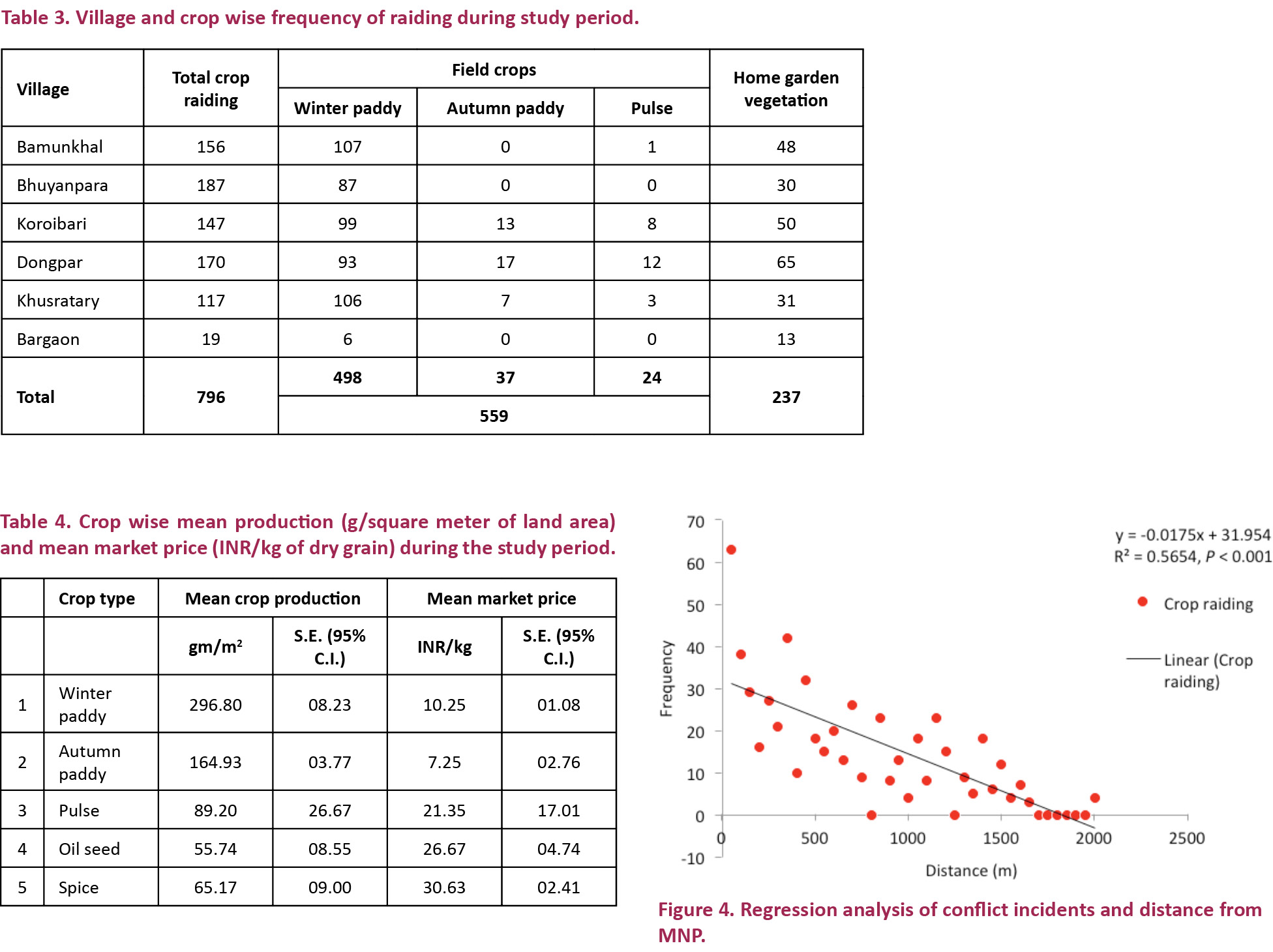
Total crop loss and their economic values
In the study site during the study period the total crop loss was 13.07 tons and its economic value was calculated to be 121.18 thousand INR (US$ 1.89 thousand).
Crop wise total loss and their values
The crop-wise maximum loss both in terms of quantity and value due to crop raiding by elephants was incurred by winter paddy (12.63 tons; 117.43 thousand INR (1.84 thousand US$)) which was followed by autumn paddy (346.35kg; 2511 INR (39.33 US$)) and pulse (57.98kg; 1238 INR (19.39 US$)).
Although the highest crop loss was incurred by winter paddy, the rate of loss showed that autumn paddy was the worst affected which incurred the highest 1.02% loss. This is because, in comparison to damage, production of autumn paddy was very low. Winter paddy incurred 0.41% loss and pulses incurred only 0.03% loss (Fig. 6).
Farmer wise crop loss and their economic values
At the individual farmer level the area of damage was recorded as a low of 0.04% (30m2 damaged out of a total of 75,517m2 cultivated) to a high of 39.49% (261 m2 damaged out of total 661 m2 cultivated). The total crop loss ranged from 3.66kg and 223.26kg and the economic loss ranged from 55 INR (0.86 US$) to 2288 INR (35.84 US$). Farmer-wise mean crop loss was 34.84±2.65 kg and mean economic loss was 564.34±56.11 INR at 95% confidence interval. The pattern of damage (highest & lowest) of different crops for individual farmers is shown in Fig. 7.
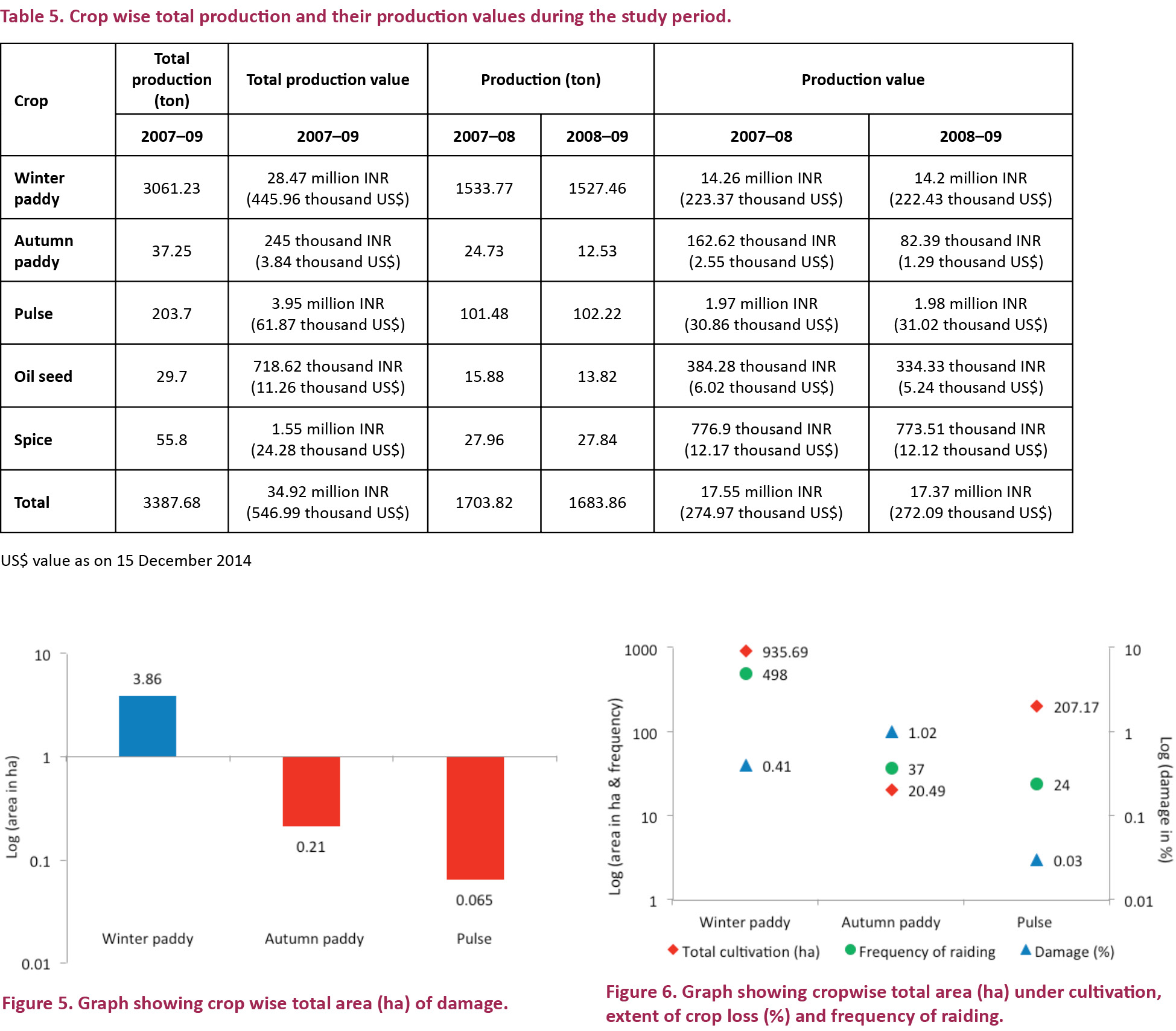
Actual value of crop loss
The actual value of crop loss was low during the study period. In comparison to the total value of crop production of 34.92 million INR (546.99 thousand US$), the total value of crop loss was 121.18 thousand INR (1.89 thousand US$) which was only 0.35%.
Crop guarding, frequency of raiding and extent of crop damage
We found that crop guarding influences the crop raiding pattern by elephants. Of the total crop raiding incidents that occurred during the study period, in 34.35% (n=192) cases the crop fields were guarded by farmers whereas, in 65.65% (n=367) cases crop fields were not guarded. The frequency of raiding (χ22= 15.3, P<0.01) and the extent of damage (independent samples t-test: t19=3.569, P<0.002) was less in crop fields which were guarded by farmers (Fig. 8).
At the 95% confidence interval, the mean crop damage in crop fields with guards was recorded to be 0.09±0.03 ha and in crop fields without guards it was 0.14±0.06 ha (Fig. 9). On analyzing the seasonal pattern, we found that only 4.69% of the affected autumn crops were guarded by farmers whereas, winter crops were guarded in 95.31% cases.
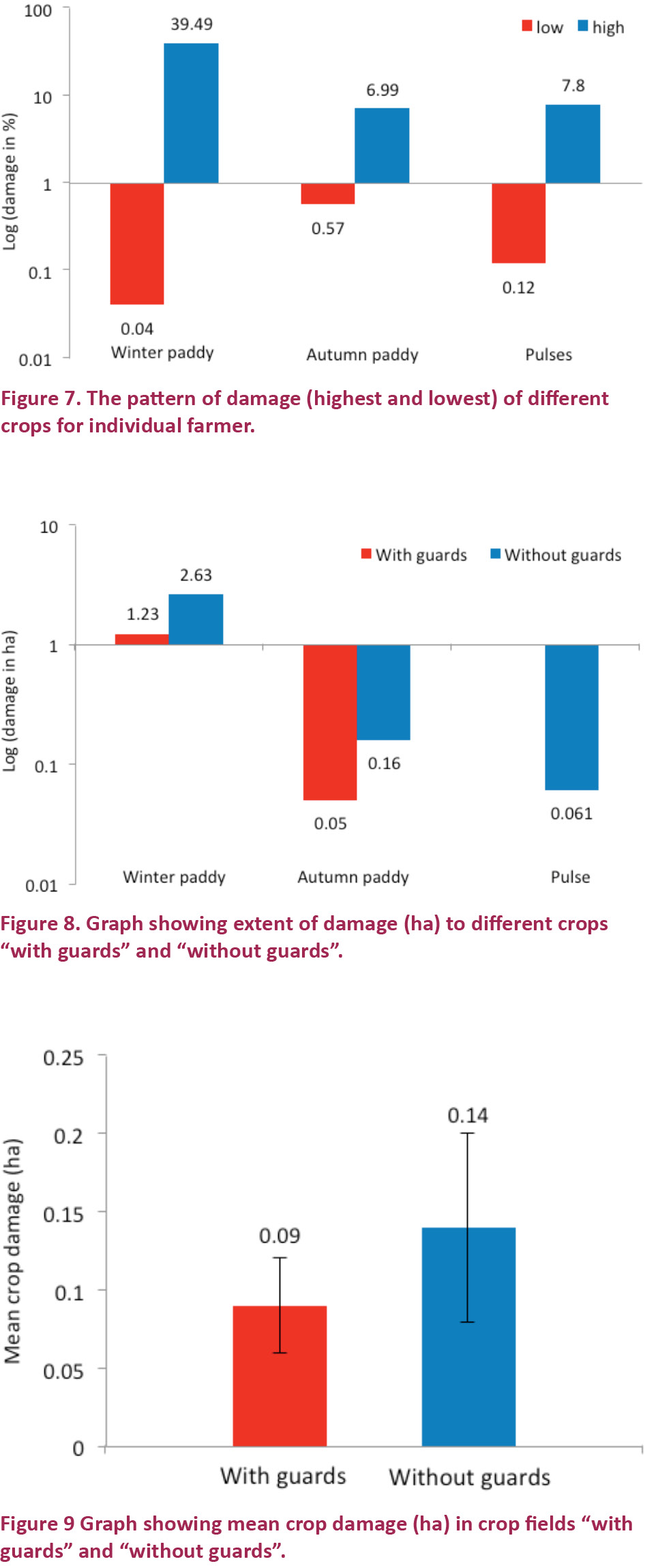
Crop damage pattern in relation to herd size
A total of 727 individual elephants were involved in 559 crop raiding incidents that caused 4.14ha of total area damage in the study area. Thus, the area of damage per elephant was 56.95m2. Single Makhnas were involved in 73.88% (n=413) of the crop raiding cases that caused 56.04% (n=2.32 ha) area damage; a herd of two (2) individuals were involved in 22.72% (n= 127) cases that caused 35.02% (n=1.45 ha) area damage; three (3) individuals were involved in 3.22% (n=18) cases that caused 7.49% (n= 0.31 ha) area damage; and six (6) individuals were involved in 0.18% (n=1) crop raiding cases that caused 1.45% (n=0.06 ha) total area of damage.
Damage to structural properties
A total of six (6) structural properties were damaged by elephant during the study period, two (2) of which were occupied houses, two (2) were occupied houses with both attached granary and kitchen and another two (2) were occupied houses with attached granary. All these structures were partially damaged and the total repairing cost was estimated to be 7800 INR (122.2 US$).
Damage to stored grains
Of the total six (6) property damage cases, loss to stored grains (paddy) occurred in four (4) cases. The total stored grain lost was estimated to be 68kg of worth 750 INR (11.75 US$).
Damage to other vegetation
Other than the cultivated crops, there was a considerable amount of damage to home gardens. The frequency of raiding of banana was found to be the highest (64.98%, n=154) (χ25=454.01, P<0.001) which was damaged at all stages of its development. On an average, six (6) banana plants (range: 3–17 plants per clump) were there in each clump and a total of 299 banana clumps were damaged. Besides banana, elephants also damaged 156 pumpkin plants, 20 jackfruit trees, 18 pineapple plants, eight bamboo groves and one coconut tree.
Ex-gratia payments
During the study period no ex-gratia payment was made to the farmers who lost their crops to elephant. However, the victims, whose structural properties were damaged by elephant, received materials such as thatch and wood as support by the forest department to repair their partially broken structures (C.R. Bhobora & A. Rabha pers. comm. 2009).
DISCUSSION & CONCLUSION
Our study in MNP showed that the extent of crop damage due to elephant was 0.32%. The study conducted in Buxa Tiger Reserve by AERCC (2003) showed an overall 3–5 % crop damage and the study conducted in Kameng Elephant Reserve, Pakke, Arunachal Pradesh by Varma et al. (2008) showed a total damage of 0.1–3 % to different crops. As the crop damage was little, the actual economic value of crop loss was also very small being only 0.35% in MNP. In their study in Pakke, Varma et al. (2008) reported the actual value of crop loss to be 0.08% to 2%. Roy & Sah (2012) during their study in Buxa Tiger Reserve reported a high of 30.61% economic loss due to elephants. These comparisons point out that HEC in MNP is not very serious and thus offers ample opportunity for long term conflict mitigation strategies along with a systematically planned conservation education and awareness program to maintain the coexistence between humans and elephants.
In MNP, crop raiding incidents were mostly concentrated along the park boundary and higher depredation occurred in the villages that were adjacent to the park (Nath et al. 2013). Among the six studied villages, we found that maximum elephant depredation occurred in the crop fields close to the Park boundary. Sukumar (1990) also observed a similar pattern and remarked that raiding of agricultural fields by elephants occurs due to proximate factors such as contact with cultivation. Studies conducted in Africa by Bell (1984), Barnes et al. (1995), Naughton-Treves (1998), Bhima (1998), O’Connell et al. (2000), and Parker & Osborn (2001), also showed similar results. In this situation, the creation of a buffer zone between MNP and the settlement area is an utmost necessity to avoid spatial landuse overlap between human and elephants. Kumar & Singh (2010) pointed out that increasing interface between humans and elephants over resources leads to high incidences of HEC in Asia. Osborn & Parker (2002) and Fernando et al. (2005) suggested that land use planning is an important component in all the places where HEC exists. Hence, both as an elephant conservation plan and as a long term HEC mitigation strategy, an integrated land use and development plan should be developed for MNP. If neglected, there is every possibility of HEC becoming unmanageable thus jeopardizing the future of Asian Elephant in this landscape (Image 1).
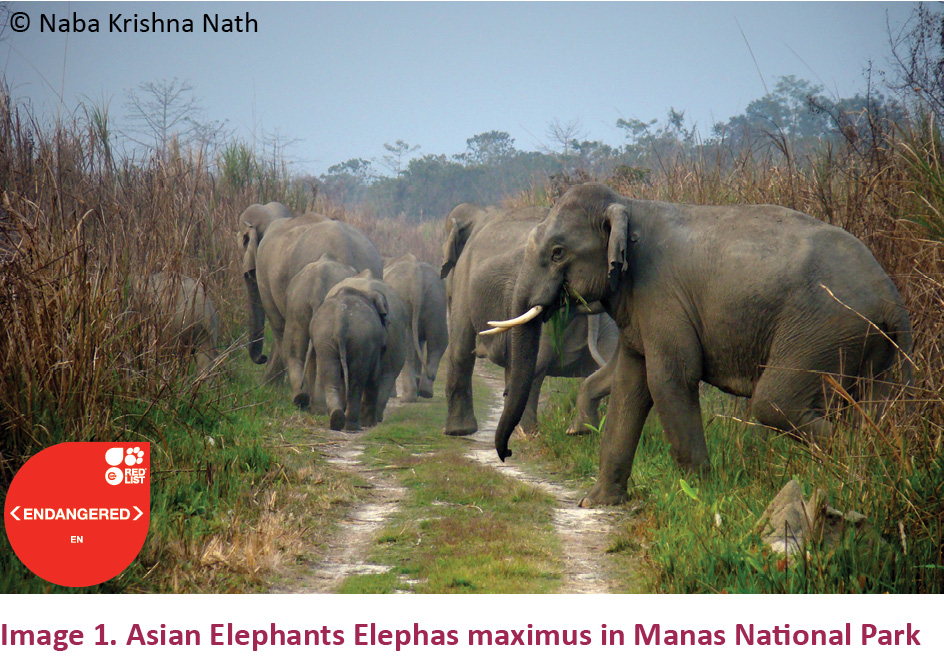
When farmers were interviewed, they revealed that earlier they used to grow autumn paddy on a large scale, almost in equal proportion to winter paddy. Autumn paddy matures and gets ready for harvest during the peak monsoon season (June−July) when crop guarding literally becomes difficult due to bad weather conditions and as a result it incurs more damage. Percentage loss as well as IR of autumn paddy was recorded to be the highest among all the three affected crops. Due to increasing incidences of elephant depredation and difficulty in crop guarding due to rain, the cultivation of autumn paddy has considerably declined to a negligible point which bears out the speculation made by Sukumar (1990) that elephants may affect agricultural practices. Although, the area under cultivation of autumn paddy was considerably less than the areas under cultivation of pulses, oil seeds and spice, autumn paddy incurred the highest rate of loss. Oil seeds and spice did not incur any damage during the study period and pulses incurred the least damage among the affected crops which suggested that these three crops were preferred less by elephant. All these three agricultural crops are economically viable due to their high market prices and hence could be important alternative crops to paddy in the fringe area of MNP.
Our study showed that economic loss due to crop raiding by elephants was almost negligible though the frequency of crop raiding was quite high. This was due to the traditional crop guarding system that has been in practice in this region. Moreover, we found that crop guarding significantly reduced the frequency of raiding as well as extent of damage. Thus, strengthening of the community crop guarding system could be a viable option for conflict mitigation in MNP which is not only cost effective but is also expected to help minimize the annual crop loss due to elephants to a large extent. Osborn & Parker (2003) also suggested that the more responsibility farmers have for crop protection, the more successful deterrence becomes. The role of external agencies and wildlife managers is, therefore, to work with farmers to develop a range of management solutions for repelling elephants. This strategy appears to have a greater chance of success than one-off technical solutions. Initiatives have already been undertaken to strengthen the traditional crop guarding system in the study site by promoting the concept of group crop guarding (Lahkar et al. 2009).
Farmers in developing countries often have limited access to cash and are rarely compensated for their losses. The individual economic losses suffered from crop-raiding therefore can be relatively high (Nyhus et al. 2005; Linkie et al. 2007; Warren et al. 2007; Lhamo 2008; Radhakrishna & Sinha 2010; Varma et al. 2011). Furthermore, farmers’ inability to mitigate crop-raiding adequately and the absence of compensation schemes may lead to retaliatory killing of problem individuals (Jackson & Wangchuk 2001; Bandara & Tisdell 2002a; Nyhus et al. 2005; Radhakrishna & Sinha 2010; Jayantha & Dunusinghe 2013). In MNP, during the study period no compensation was paid to any farmer against crop damage. Whether a compensation scheme really helps in mitigating HEC or not is still unclear but, some incentive can definitely help reduce antagonism towards elephants. Although the conflict intensity is low, four elephants were killed in retaliatory killing during the study period (Nath et al. 2013) which is a setback for elephant conservation in the area.
In MNP although the overall crop damage was less, at the individual farmer level the damage was quite high. Since the majority of the famers were poor and did not have alternate sources of income, elephant depredation severely affected their livelihoods. If the situation does not improve, farmers may develop antagonism and intolerance towards elephants which can undermine and hinder elephant conservation efforts being taken up in MNP. So, systematically planned, effective conflict monitoring and mitigation strategies need to be developed and implemented so that further escalation of the problem can be eschewed.
REFERENCES
Asian Elephant Research & Conservation Centre, AERCC (2003). Study of Elephants in Buxa Tiger Reserve and adjoining areas in Northern West Bengal and preparation of Conservation Action Plan. AERCC, Bangalore.
Balmford, A., J.L. Moore, T. Brooks, N. Burgess, L. Hansen, P. Williams & C. Rahbek (2001). Conservation conflicts across Africa. Science 291: 2616–2619.
Bandara, R. & C.A. Tisdell (2002). Asian elephants as agricultural pests: economics of control and compensation in Sri Lanka. Natural Resources Journal 42(3): 491–519.
Barnes, R.F.W., S. Asika & B. Asamoah-Boateng (1995). Timber, cocoa and crop-raiding elephants: a preliminary study from southern Ghana. Pachyderm 19: 33–38.
Bell, R.H.V. (1984). The man-animal interface: An assessment of crop damage and wildlife control, pp. 387–416. In: R.H.V. Bell & McShane-Caluzi (eds.). Conservation and Wildlife Management in Africa. US Peace Corps Seminar, Malawi.
Bhima, R. (1998). Elephant status and conflict with humans on the western bank of Liwonde National Park, Malawi. Pachyderm 25: 74–80.
CEPF (2005). Critical Ecosystem Partnership Fund, Ecosystem Profile, Eastern Himalayas Region. Final Version, February 2005. WWF-US, Asia Program, 100pp.
Ekobo, A. (1997). Elephant problem in the Mungo Division, littoral province (Cameroon). Pachyderm 24: 53–63.
Fernando, P., E. Wikramanayake, D. Weerakoon, L.K.A. Jayasinghe, M. Gunawardene & H.K. Janaka (2005). Perceptions and patterns of human-elephant conflict in old and new settlements in Sri Lanka: insights for mitigation and management. Biodiversity and Conservation 14(10): 2465–2481; http://dx.doi.org/10.1007/s10531-004-0216-z
Jackson, R. & R. Wangchuk (2001). Linking Snow Leopard conservation and people-wildlife conflict resolution: grassroots measures to protect the endangered snow leopard from herder retribution. Endangered Species Update 18: 138–141.
Jayantha, D. & P. Dunusinghe (2013). Human-Elephant conflict in Hambegamuwa, Sri Lanka: From Vulnerability to Resilience. In proceedings of International Conference on Building Resilience, 17th–19th September 2013, Ahungalle, Sri Lanka.
Kumar, M.A. & M. Singh (2010). Behaviour of Asian Elephant (Elephas maximus) in a land-use mosaic: implications for human-elephant coexistence in the Anamalai hills, India. Wildlife Biology in Practice 6: 69–80; http://dx.doi.org/10.2461/wbp.2010.6.6
Lahkar, B.P., J.P. Das, N.K. Nath, P.K. Sarma & K. Brahma (2009). Conservation of Asian Elephant Elephas maximus through Research, Education and Community participation in Manas National Park, India. Technical Report_Aaranyak_ERCI_01/2009.72pp.
Lahm, S.A. (1996). A nationwide status survey of crop raiding by elephants and other species in Gabon. Pachyderm 21: 69–77.
Lhamo, N. (2008). Extent of human-elephant conflicts and the threat to elephant populations in southern Bhutan. Master’s Thesis.University of Natural Resources and Applied Life Sciences, Vienna, 75pp.
Linkie, M., Y. Dinata, A. Nofrianto & N. Leader-Williams (2007). Patterns and perceptions of wildlife crop raiding in and around Kerinci Seblat National Park, Sumatra. Animal Conservation 10(1): 127–135; http://dx.doi.org/10.1111/j.1469-1795.2006.00083.x
Nath, N.K., B.P. Lahkar, N. Brahma, S. Dey, J.P. Das, P.K. Sarma & B.K. Talukdar (2009). An assessment of human-elephant conflict in Manas National Park, Assam, India. Journal of Threatened Taxa 1(6): 309–316; http://dx.doi.org/10.11609/JoTT.o1821.309-16
Nath, N.K., S.K. Dutta, J.P. Das & B.P. Lahkar(2013). Human-Elephant interaction in villages around Manas National Park, Assam, India. Gajah 39: 12–18.
Naughton-Treves, L. (1998). Predicting Patterns of Crop Damage by Wildlife around Kibale National Park, Uganda. Conservation Biology 12(1): 156–158; http://dx.doi.org/10.1111/j.1523-1739.1998.96346.x
Ngure, N. (1995). People-elephant conflict management in Tsavo, Kenya. Pachyderm 19: 20–25.
Nijman V. & K.A.I. Nekaris (2010). Testing a model for predicting primate crop-raiding using crop and farm-specific risk values. Applied Animal Behaviour Science 127(3–4): 125–129; http://dx.doi.org/10.1016/j.applanim.2010.08.009
Nyhus, P.J., S.A. Osofsky, P. Ferraro, F. Madden & H. Fischer (2005).Bearing the costs of human-wildlife conflict: The challenges of compensation schemes, pp. 107–121. In: Woodroffe, R., S. Thirgood & A. Rabinowitz (eds.). People and Wildlife: Conflict or Coexistence? Cambridge University Press, London; http://dx.doi.org/10.1017/cbo9780511614774.008
O’Connell-Rodwell, C.E., T. Rodwell, M. Rice & L.A. Hart (2000).Living with the modern conservation paradigm: can agricultural communities co-exist with elephants? A five-year case study in East Caprivi, Namibia. Biological Conservation 93(3): 381–391; http://dx.doi.org/10.1016/s0006-3207(99)00108-1
Osborn, F.V. & G.E. Parker (2002). Living with elephants II; a manual. MZEP, 37 Lewisam Ave, Chisipite, Harare, Zimbabwe, 21pp.
Osborn, F.V. & G.E. Parker (2003).Towards an integrated approach for reducing the conflict between elephants and people: a review of current research. Oryx 37(1): 80–84; http://dx.doi.org/10.1017/s0030605303000152
Osei-Owusu, Y. & L. Bakker (2008). “Human-Wildlife Conflict, FAO”. Elephant Technical Manual, 45pp.
Parker, G.E. & F.V. Osborn (2001). Dual-season crop damage by elephants in eastern Zambezi Valley, Zimbabwe. Pachyderm 30: 49–56.
Pimm, S., G. Russell, J. Gittleman & T. Brooks (1995). The future of biodiversity. Science 269(5222): 347–350; http://dx.doi.org/10.1126/science.269.5222.347
Radhakrishna S. & A. Sinha (2010). Living with Elephants: Exploring the Nature and Cause of Human-Elephant Conflict in India. NIAS Backgrounder on Conflict Resolution, B2-2010, National Institute of Advanced Studies, Bangalore, 39pp.
Rahmani, A.R., G. Narayan, R. Sankaran & L. Rosalind (1988). The Bengal Florican, status and ecology, annual report 1986–87. Bombay Natural History Society, Bombay, India, 209pp.
Rahmani, A.R., G. Narayan & L. Rosalind (1989). Threat to India’s Manas Tiger Reserve. Unpublished report for the Ministry of Environment & Forests, 12pp.
Roy, P.B. & R. Sah (2012). Economic loss analysis of crop yield due to elephant raiding: a case study of Buxa Tiger Reserve (West) West Bengal, India. Journal of Economics and Sustainable Development 3(10): 83–88.
Sarma, P.K., B.P. Lahkar, S. Ghosh, A. Rabha, J.P. Das, N.K. Nath, S. Dey & N. Brahma (2008). Land use and Land cover change and future implication analysis in Manas National Park, India using Multi-temporal satellite data. Current Science 95(2): 223–227.
Sukumar, R. (1990). Ecology of the Asian elephant in southern India: II. Feeding habits and crop raiding patterns. Journal of Tropical Ecology 6(1): 33–53; http://dx.doi.org/10.1017/s0266467400004004
Thouless, C.R. (1994). Conflict between human and elephants on private land in northern Kenya. Oryx 28(2): 119–127; http://dx.doi.org/10.1017/s0030605300028428
Varma, S. & B.P. Lahkar (2006). Capacity building on elephant research and conservation issues in northeast India. An unpublished technical report prepared by Aaranyak and Asian Elephant Research and Conservation Centre (AERCC), 61pp.
Varma, S., K.G. Avinash & L. Vinay (2011). Human-Elephant Conflict in Mysore Forest Division: Patterns, Causes and Responses. Asian Nature Conservation Foundation, Bangalore, 165pp.
Varma, S., P. Sarkar & V. Menon (2008). Pakke Pachyderms: Ecology and Conservation of Asian elephant in Kameng Elephant Reserve, Arunachal Pradesh. Widlife Trust of India, New Delhi, 148pp.
Warren, Y., B. Buba & C. Ross (2007). Patterns of crop-raiding by wild and domestic animals near Gashaka Gumti National Park, Nigeria. International Journal of Pest Management 53(3): 207–216; http://dx.doi.org/10.1080/09670870701288124
Williams, A.C. & A.J.T. Johnsingh (1997). A Status Survey of Elephants (Elephasmaximus), their Habitats and an Assessment of the Elephant-Human Conflict in Garo Hills, Meghalaya. Wildlife Institute of India. Dehra Dun, India.
Woodroffe, R. & J. Ginsberg (1998). Edge effects and the extinction of populations inside protected areas. Science 280(5332): 2126–2128; http://dx.doi.org/10.1126/science.280.5372.2126